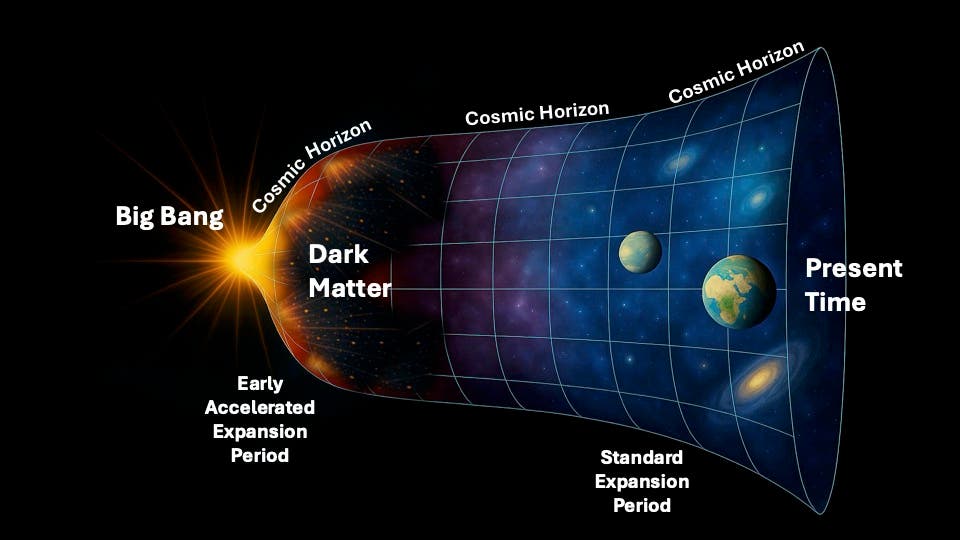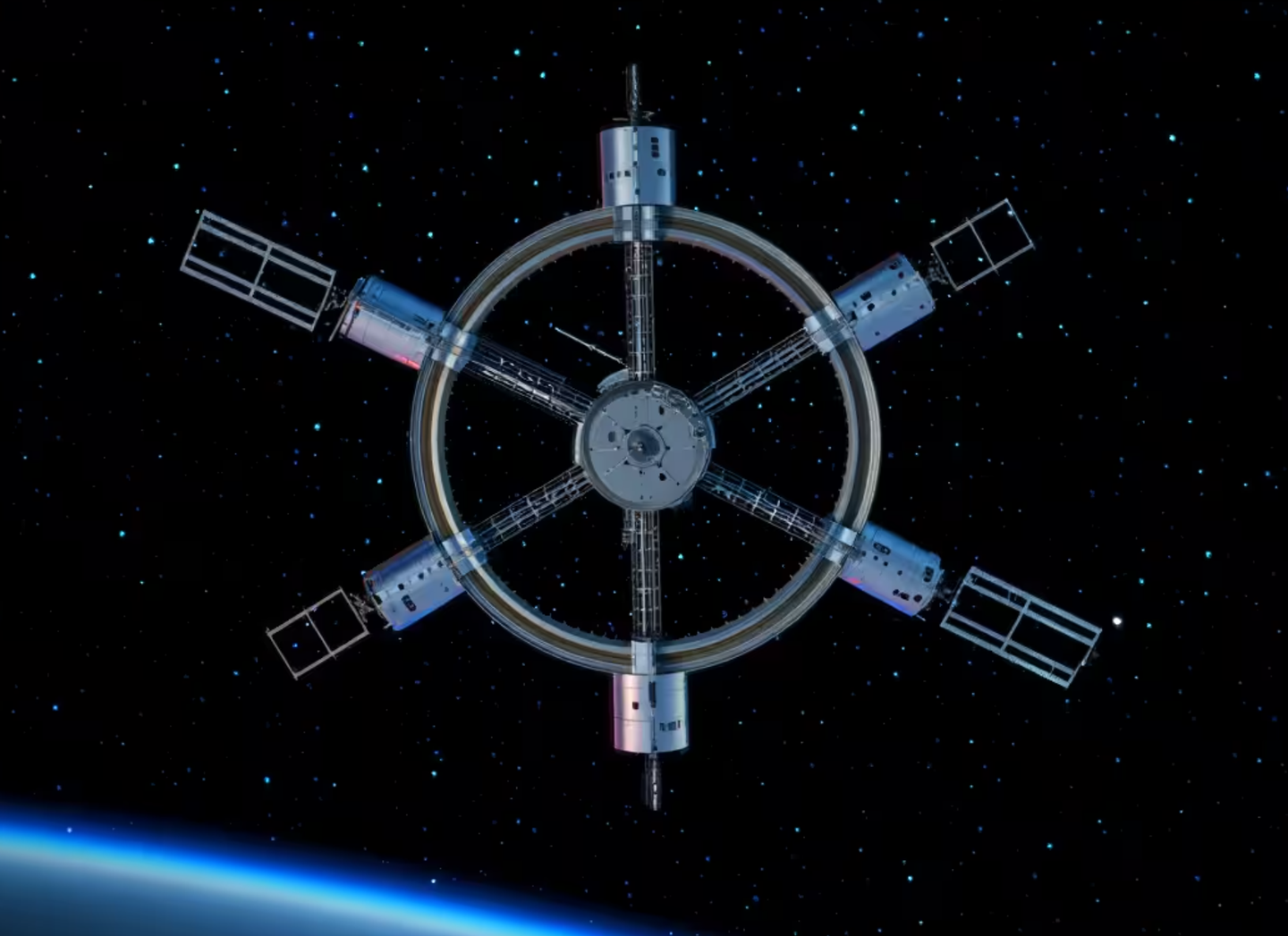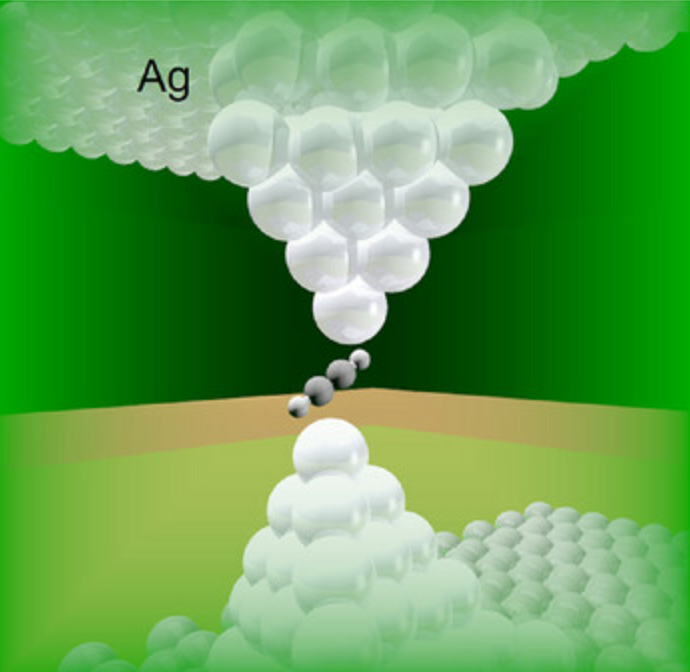Two bold dark matter theories could reveal the universe’s missing mass
Two dark matter origin theories—mirror worlds and hot horizons—offer testable, data-driven paths to the universe’s missing mass.

An artistic rendering of Professor Stefano Profumo’s theory, in which quantum effects at the rapidly expanding cosmic horizon after the Big Bang give rise to dark matter particles through gravity. (CREDIT: Stefano Profumo)
Two fresh ideas are giving scientists new ways to think about how the universe’s hidden mass came to be. Together, they paint a richer picture of dark matter’s origins and how we might still discover it. One idea points to a “mirror world,” a hidden twin of ordinary particles.
The other treats the edge of the young universe as a hot surface that could create particles, much like a black hole horizon. Both offer clear predictions that can be checked against data, stay within the rules of established physics, and take dark matter origin theories in bold new directions.
How the puzzle became sharper
Evidence for invisible matter has been building for decades. Galaxies spin too quickly, clusters bend light more than expected, and patterns in the early universe only make sense if most matter is dark. Today, scientists believe close to 85% of all matter is dark, cold, and slow-moving on cosmic scales.
Despite many clever searches, the most popular dark matter candidates have evaded detection. This string of null results has pushed theorists to explore new ground. Physicist Stefano Profumo at the University of California, Santa Cruz sums it up: “Both mechanisms are highly speculative, but they offer self-contained and calculable scenarios that don’t rely on conventional particle dark matter models, which are increasingly under pressure from null experimental results.”
Dark matter origin theories in two new lanes
The first idea, published in the journal arXiv, imagines a mirror sector—a duplicate of known particles and forces that interacts only weakly with our own. In this hidden world, a version of the strong force could bind “dark quarks” into heavy “dark baryons.” Early in cosmic history, these could have collapsed into tiny, stable relics, similar to miniature black holes. If made in the right numbers, they could account for all the missing mass while staying invisible to current detectors. The appeal is that it uses familiar physics—just applied to a hidden copy of the universe.
The second idea, published in the journal Physical Review D, turns the expanding horizon of the early universe into a particle factory. After inflation, the cosmos might have gone through a short burst of accelerated expansion. In this state, the cosmic horizon would have a temperature and radiate particles, much like a black hole does. If stable particles were created this way, they could make up dark matter across a huge range of possible masses, from thousands of electron volts to near the Planck scale.
Related Stories
- Dark matter particles may live longer than the universe itself, study finds
- Microscopic magnet powers search for dark matter in the universe
- Black holes could reveal the universe’s most hidden particles - possibly even dark matter
What the mirror world adds—and demands
Mirror world models have been around for years, but a new study sharpens how they could explain why the amount of dark matter is close to the amount of normal matter. The idea uses a process called the Affleck–Dine mechanism to create an imbalance in both sectors, producing more matter than antimatter. This avoids relying only on matter-antimatter annihilation.
The model predicts two main possibilities. In one, mirror electrons—with masses of a few billion electron volts—are the dark matter. In the other, dark matter is made of mirror baryons. In both cases, the theory expects a “mirror photon” with a mass in the million-electron-volt range. This photon would help explain the smoothness of small galaxies without conflicting with large-scale structures. The model also predicts a small but measurable extra amount of early-universe radiation—something future cosmic background surveys could detect.
On the horizon of creation
Profumo’s second proposal is simpler in setup. Imagine the universe just after inflation, in a nearly steady expansion phase. In this state, the cosmic horizon acts like a hot surface, creating particles from quantum effects. If those particles are stable and interact only through gravity, they could remain as dark matter today. The final amount depends only on the conditions during this phase and the temperature when normal expansion took over. By measuring certain features of the early universe, scientists could quickly narrow down the possible mass of this type of dark matter.
Fitting with what we already know
Both theories prefer dark matter that interacts very weakly, which fits with years of experimental results that have found no signs of strongly interacting particles. Observations of cosmic structure also match dark matter that is cold or only slightly warm, something both ideas can produce.
How to put these theories to the test
The mirror world idea can be checked in several ways:
- Small galaxies: Self-interacting dark matter changes the centers of dwarf galaxies, which better maps of stars could reveal.
- Early radiation: Any extra radiation from the mirror world would leave a mark in the cosmic microwave background.
- Mirror photon effects: A MeV-scale mirror photon would affect how structures form and could be spotted indirectly.
The horizon production idea would be tested by looking for:
- Primordial signals: Gravitational waves or small deviations in early expansion could point to a short accelerated phase.
- Mass limits: Knowing the temperature at the end of this phase would narrow the possible mass range for the dark matter.
A growing community effort
Both proposals sit inside a wider push toward dark-sector and gravitational production models. Workshops and new studies are already exploring similar concepts, from dark photons to inflation-linked particle creation. The work reflects a shift from focusing only on “what particle is it” to also asking “what process made it.”
Why this matters
These dark matter origin theories offer a new way forward. Instead of only chasing particles in labs, they open the door to finding dark matter clues in galaxy surveys, cosmic background maps, and gravitational wave detectors. For science communication, they keep the story moving—showing that the field adapts when old favorites go silent.
The limits
Every bold idea has boundaries. Mirror sectors could produce too much radiation or disrupt galaxy formation unless parameters are tuned carefully. The horizon theory must fit into a very short time window without spoiling the standard Big Bang picture. Both teams have outlined the conditions needed for their models to work, giving observers clear targets.
Where the hunt goes from here
The next steps include mapping small galaxies with better detail, improving lensing studies of low-mass halos, measuring early-universe radiation with new background surveys, and looking for evidence of short-lived accelerated expansion after inflation. These paths may not lead to a single answer, but they will rule out or support ideas with precision.
In short, dark matter origin theories are moving beyond the well-worn paths of thermal freeze-out and into fresh territory, where gravity, cosmic horizons, and shadow copies of known physics point the way. They may sound strange, but they give scientists concrete predictions to test in the coming years.
Note: The article above provided above by The Brighter Side of News.
Like these kind of feel good stories? Get The Brighter Side of News' newsletter.



